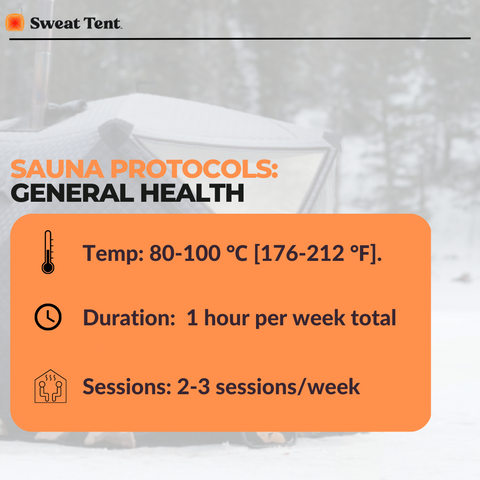Deliberate heat exposure through sauna can significantly improve physical and mental health, health span and reduce all-cause mortality (death from any cause). If you’re here, you’re likely familiar with the idea that sauna use can benefit your health. But how long should you sit in a sauna to reap the benefits? Well, here's the short answer from a general health perspective:
- 20 minute session, 2-3 times per week at a temperature range of 176-212F
For more detail and sauna suggestions based on health goals, consider reading on!
In this article, we'll discuss the data behind how long you should stay in a sauna to improve cardiovascular health, increase the release of human growth hormone, and promote general health—a broad category encompassing several areas of wellness, including mental and cognitive health, focus, sleep, physical performance and recovery, and more.
Before we dive into the science and protocols of how long to stay in a sauna to improve health, let’s discuss sauna bathing basics and general sauna precautions for a safe and effective sweat.
What We’ll Cover:
1. What is Dry Sauna Bathing?
2. General Sauna Precautions
2.1 The Importance of Building Heat Tolerance
2.2 Special Populations
3. Three Benefits & Science-Backed Sauna Protocols for Optimizing Health
3.1 Sauna for Improved Cardiovascular Health
3.2 Sauna for Human Growth Hormone Release
3.3 Sauna for General Health
4. Observational Data: Sauna Use for Reduced Risk of Alzheimer’s & Dementia
5. Conclusion
What is Dry Sauna Bathing?
Dry sauna bathing is a centuries-old global practice still used today. This method of deliberate heat exposure involves exposing oneself to high temperatures in a dry environment (generally between 80°C to 100°C, or 176°F to 212°F) traditionally fueled by wood-fired heat.
During a typical session, the air inside the sauna is kept dry, with humidity levels sit somewhere between 10 and 20 percent. This differs from steam rooms, which use wet heat and have much higher humidity levels. With low humidity and high levels of heat, the body tries to cool down and restore balance, causing a thermoregulatory response: sweat.
As you’ll soon learn, the physiological events that occur during a typical sauna session can significantly improve short and long term health in a variety of areas, from reduced stress to prevention of chronic and life-threatening diseases.
General Sauna Tips & Precautions
The average person loses about 0.5 kg of sweat while sauna bathing. To ensure proper hydration and electrolyte replenishment, it's vital to drink ample amounts of water (about 16 ounces for every 10 minutes of sauna use) before and after using the sauna. You’ll also want to avoid alcohol before and after sauna useTo help make your sauna session as comfortable as possible, wear loose, breathable fabrics like cotton or bamboo, which allow air to move freely. It’s also acceptable to go shirtless or unclothed, depending on your preferences.
The Importance of Building Heat Tolerance
While the listed protocols below dictate how long you should sit in a sauna to unlock specific health benefits, it’s important to also consider your sauna experience and general heat tolerance. To maximize safety and efficacy with every sauna session, it’s best to slowly build your heat tolerance.
In terms of safety, your personal heat tolerance should determine the actual sauna temperature and how long you should stay in the sauna.
Just like an extreme drop in body temperature can lead to hypothermia, an excessive rise in body temperature can result in a dangerous level of hyperthermia, both of which can be life-threatening. If you're new to dry sauna therapy, start with a less demanding temperature that still makes you sweat and induces a feeling of discomfort without feeling dangerously hot. Always listen to your body and never push yourself beyond what feels unsafe.
In terms of efficacy, it's best to slowly increase your heat tolerance over time rather than going “all in” with the highest temperature you can handle. Doing so will help maximize the benefits of each sauna session and prolong the effects and benefits of your sauna experience.
Special Populations
Sauna use is not recommended for individuals under 16, or women who are pregnant or breastfeeding. Additionally, If you have high blood pressure, heart disease, or are taking any special medication, it's best to consult with your doctor before sauna use of any kind. If you feel unwell, it’s best to avoid the sauna altogether.
Three Science-Backed Sauna Protocols to Optimize Your Health
Sauna for Improved Cardiovascular Health
If your goal is to improve cardiovascular health, sauna is one effective tool worth your consideration–and there’s plenty of data to prove it.
Finnish cardiologist and leader in modern sauna research, Dr. Jari Laukkanen, conducted multiple studies indicating that regular use of a dry sauna promotes a multitude of cardiovascular health benefits.
The Kuopio Ischemic Heart Disease Risk Factor (KIHD) study followed over 2,300 middle-aged men in eastern Finland. The findings revealed those who used the sauna two to three times per week reduced their risk of dying from cardiovascular-related causes by 27 percent.
The benefits were even greater for those who used the sauna more frequently and for longer sessions, with a 50 percent reduction in risk for men who used the sauna four to seven times per week. In addition, frequent sauna use reduced the risk of all-cause premature death by 40 percent.
Another study in 2018 by Laukkanen et al., revealed similar findings. It examined 1,688 participants (almost an even split of men and women with an average age of 63) over a 15-year period. Both studies reported the cardiovascular benefits of sauna use were dose-dependent, meaning that the more frequently the sauna was used, the greater the benefits.
These benefits persisted even after considering other factors that could affect health outcomes, such as age and activity level. These findings indicate that regular use of a sauna can be an effective tool in reducing the risk of cardiovascular events. Here’s how long to stay in the sauna for improved cardiovascular health:
Sauna For Growth Hormone Release
Growth hormone is an important factor affecting muscle growth, bone strength, tissue repair, and metabolism. While natural production of growth hormone decreases as we age, studies show that specific sauna protocols can significantly increase growth hormone release (up to 16-fold, in some cases), and continue to release growth hormones a few hours after sauna use. So, how long should you sit in a sauna to capitalize on these growth and recovery benefits?
You might be surprised to learn the protocol for maximizing growth hormone release involves infrequent sauna use of once per week or less. This protocol calls for multiple sessions in the sauna for 30 minutes each, with five minute cool down periods in between. Repeat the 30/5 sauna and cool off routine a few hours later for a total of four sauna sessions per day to optimize growth hormone release.
Extra Tips for to Maximize Growth Hormone Release
For maximum growth hormone release, use the sauna in a semi-fasted state (no food two to three hours beforehand). To further enhance metabolic benefits, use the sauna after a workout, and/or alternate periods of sauna with deliberate cold exposure during rest periods, like an ice bath, jumping into cold water, or taking a cold shower.
Using the sauna more than the recommended protocol can impede the release of human growth hormone.
Sauna For General Health
Sauna is an excellent tool proven to optimize physical and mental health.
Neuroscientist and tenured professor at Stanford School of Medicine professor Andrew Huberman Ph.D explains that deliberate heat exposure can significantly reduce cortisol levels and activate heat shock proteins, which play a crucial role in enhancing DNA repair and promoting overall health. Additionally, the hormetic response pathways stimulated by sauna use can help the body adapt to stressors and better manage stress.
Regular sauna use has also been found to positively impact on mental health by reducing symptoms of depression and anxiety. This is because sauna use triggers the release of dynorphins and endorphins in the brain, which promote feelings of happiness and well-being.
By following recommended sauna protocols, individuals can optimize the numerous health benefits associated with sauna use and improve their overall wellness. If a general health goal of yours is to improve your quality of sleep, try this sauna protocol in the late afternoon or evening. Doing so will initiate the body’s post cooling response, helping you achieve more restful sleep and in turn, promote general health.
Here’s how long to stay in the sauna to promote general health and wellbeing:
Unlock Your Full Potential with Sweat Tent
Saunas have been used for centuries to promote countless areas of physical health, mental health, and overall well being. By following the sauna protocols outlined above, you can improve your health, recovery, and quality of life now and in the long term.
Now that you know how long to stay in a sauna for your health goals, make it part of your daily routine with Sweat Tent’s wood-fired home sauna tent.
This powerful, portable, anywhere sauna delivers the same powerhouse benefits of a traditional wood-burning sauna, without the hefty price tag or contractor headaches. With zero electricity required, no EMF risk, three minute setup, and 200°F of heat in any environment, you’ll be reaping the benefits of ancient sauna therapy in no time.
See Sweat Tent in action on Instagram (@sweattents), or share your own experiences with us using the hashtag #sweattent.
Medical disclaimer: This post is intended for informational purposes only and is not a substitute for professional medical advice. Please consult with your doctor before adding sauna bathing to your health and wellness routine.
Additional Resources:
https://www.foundmyfitness.com/topics/sauna#bibid-37114b56abf608a53737e22fc49ef11d
https://hubermanlab.com/deliberate-heat-exposure-protocols-for-health-and-performance/
https://jamanetwork.com/journals/jamainternalmedicine/fullarticle/2130724
https://bmcmedicine.biomedcentral.com/articles/10.1186/s12916-018-1198-0
https://onlinelibrary.wiley.com/doi/10.1111/j.1748-1716.1986.tb08000.x








